Tuesday 31 March 2015
Binarism
Even though it's common knowledge that our most distant prehistoric ancestors had no sex or gender at all, much of Western society seems reluctant to consider the possibility that there are many people who also don't fit neatly into the binary categories of “male” and “female”.
Outside of the Western world, people knew there were more than two genders thousands of years before white authorities even considered it: Two-Spirit people of North American tribes, Hijra of India, Fa'afafine of American Samoa, for example. It's never been a new thing.
Many people act as if “male” and “female” are the only notable differences between people, ignoring the multitude of other intersections. But what about when someone is neither strictly “male” or “female”?
In a purely scientific, biological context, it's not as simple as the two. Over 3 million people worldwide have been identified as intersex, a term that covers a variety of chromosonal and genital “abnormalities”. In less documented study, many people - regardless of the gender they were designated at birth - are nonbinary: not exclusively male or female, maybe both, maybe neither, maybe another combination, it depends on the person.
So, we need to learn to accept intersex and trans nonbinary people as genuine people who really do exist. For too long we've been focused on being one of two, but that's not accurate or representative of the realities of gender.
Subscribe to:
Posts (Atom)
